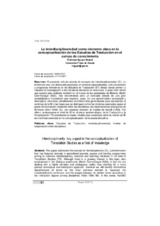Mostrar el registro sencillo del ítem
La interdisciplinariedad como elemento clave en la conceptualización de los Estudios de Traducción en el campo de conocimiento
| dc.contributor.author | Aguayo Arrabal, Natividad | |
| dc.date.accessioned | 2018-06-19T10:02:57Z | |
| dc.date.available | 2018-06-19T10:02:57Z | |
| dc.date.issued | 2017 | |
| dc.identifier.issn | 2255-3703 | |
| dc.identifier.uri | http://hdl.handle.net/10396/16964 | |
| dc.description.abstract | El presente artículo aborda el concepto de interdisciplinariedad (ID), un fenómeno con una destacada presencia en revistas especializadas, comunicaciones y programas formativos en los Estudios de Traducción (ET) desde donde animan a impulsar la investigación o las iniciativas docentes en esta línea. A pesar del interés que suscita esta realidad, también en el marco de los postulados de Bolonia (Berlin Communiqué 2003), nos encontramos ante un concepto dotado de una gran complejidad e imprecisión que requiere, pues, de una aproximación conceptual y descriptiva. Asimismo, detallaremos el método más generalizado para representar el continuo de la ID y las fases que se distinguen entre los términos asociados según el grado de interacción existente entre las disciplinas: las clasificaciones jerárquicas de términos (Klein 1990: 56), con especial atención al modelo de Kaindl (1999). Por último, evaluaremos el nivel de ID en el plano epistemológico de la Traducción y la Interpretación (TI) atendiendo al citado modelo para evidenciar cómo la noción de ID se manifiesta esencial en la conceptualización de la propia disciplina. | es_ES |
| dc.description.abstract | This paper addresses the concept of interdisciplinarity (ID), a phenomenon that has featured strongly in specialised journals, papers and training programmes aiming to enhance interdisciplinary research and teaching initiatives in the field of Translation Studies (TS). Although there is a growing interest in this topic, also emphasized in the Bologna statements (Berlin Communiqué 2003), in fact we are dealing with a highly complex and ambiguous reality, thus claiming for a more precise conceptual and descriptive approach. Likewise we will identify hierarchical classifications of terms as the most common method to represent the interdisciplinarity continuum and the stages between its related terms according to the interaction degree among disciplines (Klein 1990: 56). In this sense, Kaindl’s terminological hierarchy (1999) will be highlighted as the main model in our study since it will be valuably used to assess the stages of ID in the epistemological level of Translation and Interpreting Studies. Following this analysis, the results reveal that the concept of ID is to be considered notably significant regarding the definition itself of the discipline of TS. | es_ES |
| dc.format.mimetype | application/pdf | es_ES |
| dc.language.iso | spa | es_ES |
| dc.publisher | UCOPress | es_ES |
| dc.rights | https://creativecommons.org/licenses/by/3.0/ | es_ES |
| dc.source | Skopos 8, 3-26 (2017) | es_ES |
| dc.subject | Estudios de Traducción | es_ES |
| dc.subject | Interdisciplinariedad | es_ES |
| dc.subject | Niveles de cooperación entre disciplinas | es_ES |
| dc.subject | Translation Studies | es_ES |
| dc.subject | Interdisciplinarity | es_ES |
| dc.subject | Levels of cooperation between disciplines | es_ES |
| dc.title | La interdisciplinariedad como elemento clave en la conceptualización de los Estudios de Traducción en el campo de conocimiento | es_ES |
| dc.title.alternative | Interdisciplinarity: key aspect in the conceptualization of Translation Studies as a field of knowledge | en |
| dc.type | info:eu-repo/semantics/article | es_ES |
| dc.relation.publisherversion | https://www.uco.es/ucopress/ojs/index.php/skopos/index | es_ES |
| dc.rights.accessRights | info:eu-repo/semantics/openAccess | es_ES |

